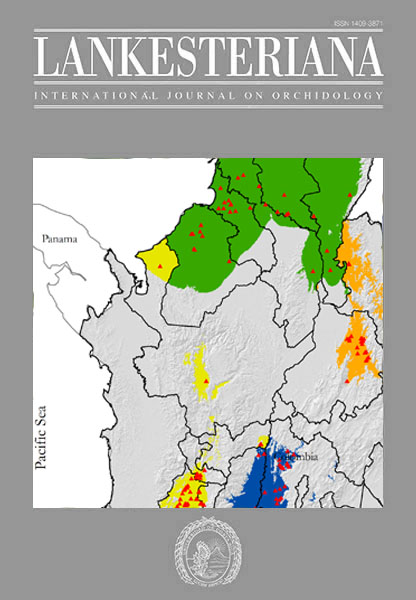Orchids distribution and bioclimatic niches as a strategy to climate change in areas of tropical dry forest in Colombia
DOI:
https://doi.org/10.15517/lank.v17i1.27999Keywords:
bioclimatic niches, climate change, Euglossini, orchidsAbstract
Climate change projections in Colombia predict an average increase in temperature of 2.6°C and in precipitation of 20% by the end of the century. These changes would directly affect the tropical dry forest (TDF) and its biodiversity. Epiphytic orchids, more exposed to the atmosphere than the terrestrial biota, remain dependent on climatic variables, making them particularly susceptible to climate change. We studied the spatial and temporal changes of a focal group of 12 orchid species typical of the TDF in Colombia, and the future conservation areas to this ecosystem. The algorithm used by MaxEnt was employed for modelling. A total of 439 records: direct observations (276); herbaria collections (159) and bibliographical sources (4) collected since September 2009 to April 2015 were considered for use in training the model. The actual potential niche was compared to the SRES 8.5 climate change emissions scenario for two periods: 2020–2049 (2030) and 2040–2069 (2050). The results indicate an altitudinal displacement compared to the present, conditioned by variables such as temperature, accessibility and precipitation. Mid-mountain areas (1300–1700 m) increased their idoneity in future potential niche models (2030 and 2050) to the detriment of the lowlands (0–1000 m). Other variables analysed, such as distance thresholds of pollinators (Euglossini), availability of phorophytes, and distances to TDF cover and protected areas, all suggest an improving connectivity between the lowland and mid-mountain areas. Consequently, bioclimatic niches (BN) are proposed as a new landscape management unit. Throughout the country, 69 of these BN were located as an adaptation-conservation strategy against climate change in the TDF in Colombia..
Downloads

Downloads
Published
How to Cite
Issue
Section
License
According to the Open Access policy promoted by the University of Costa Rica, all the papers published by Lankesteriana are licensed under the Creative Commons copyright and can be downloaded free of charge. The journal holds copyright and publishing rights under the CC BY-NC-ND 3.0 CR license.
Before the publication of the materials submitted by the author(s) in LANKESTERIANA, the author(s) hereby assign all rights in the article to the Lankester Botanical Garden.




